I never learned to clean the house and KEEP IT CLEAN. So I found out how a 1940s housewife would keep her home clean. Here’s the vintage step-by-step method that keeps the house clean and COMPANY-READY, even for a modern home: the 1940s housewife cleaning schedule.
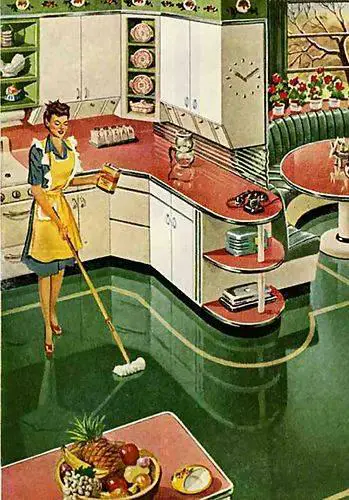
- 1940s Housewife Cleaning Schedule
- Building a 1940s Housewife Cleaning Schedule
- The 1940s Housewife Daily Cleaning Schedule
- Daily Cleaning Routine For The Living Room
- Daily Cleaning Routine For The Dining Room
- Daily Cleaning Routine For The Bedrooms
- Daily Cleaning Routine For The Nursery Or Small Child’s Bedroom
- Daily Cleaning Routine For The Bathrooms
- Daily Cleaning Routine For The Halls And Stairs
- Daily Cleaning Routine For The Kitchen
- The 1940s Housewife Weekly Schedule
- The 1940s Housewife Weekly Cleaning Schedule
- The 1940s Housewife Spring Cleaning Routine And Fall Cleaning Routine
- Spring Cleaning Routine For Closets and Bureau Drawers
- Spring Cleaning Routine For Home Furnishings
- Spring Cleaning Routine For The Basement
- Spring Cleaning Routine For The Attic
- Spring Cleaning Routine For The Living Room
- Spring Cleaning Routine For The Dining Room
- Spring Cleaning Routine For The Bedrooms
- Spring Cleaning Routine For The Bathrooms
- Spring Cleaning Routine For The Kitchen
- Storm Windows, Screens, and Awnings
- What About Decluttering?
- Looking for more 1940s Cleaning Schedules?
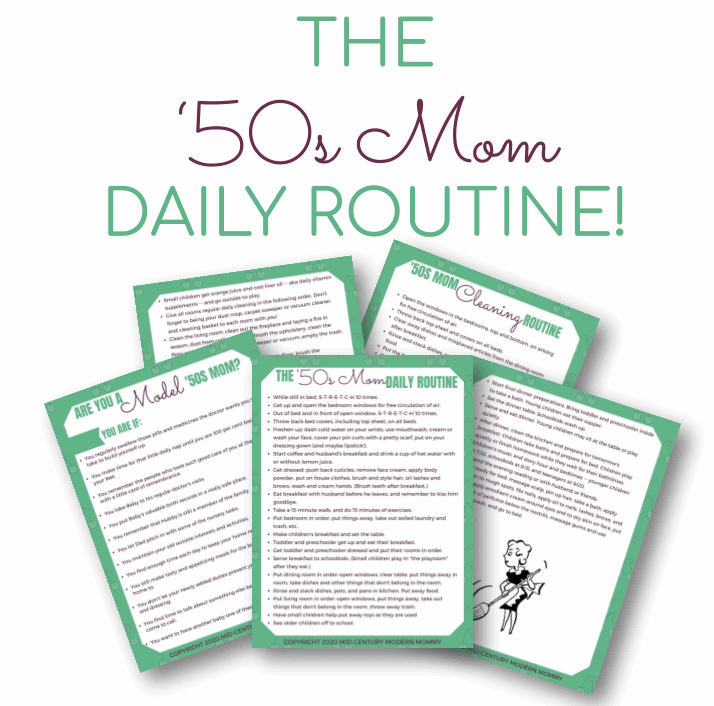
Get Our Mid-Century Mom Daily Routine FREE!
1940s Housewife Cleaning Schedule
A 1940s housewife had a schedule that included time for each of her cleaning routines. Her daily routine to clean the house was to open the windows, pick up and put away anything out of place, dust, vacuum and sweep the floors, make the beds, clean the bathrooms, clean the kitchen, empty the trash, and take the laundry to the laundry room.
Her weekly routine was to wash on Monday, iron on Tuesday, mend and polish on Wednesday, run errands on Thursday, clean on Friday, and bake on Saturday. Sunday was a day of rest.
Building a 1940s Housewife Cleaning Schedule
This post contains affiliate links. If you click a link and make a purchase, I may receive, at no additional cost to you, a small commission. Find out more on my Disclosures page, and thank you so much for your support!

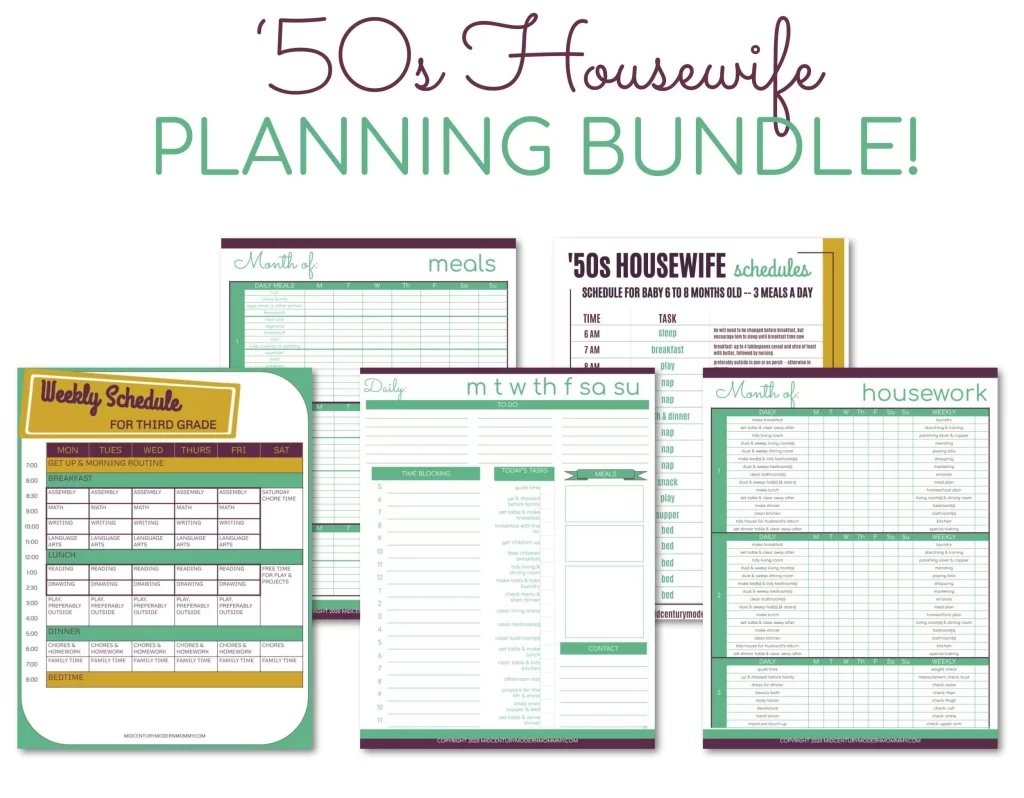
The 1940s Housewife Daily Cleaning Schedule
Daily cleaning consists chiefly of putting things away where they belong, and getting dust out of the house.
Dust was considered a HUGE problem for health, not just cleanliness. It caused sneezing and coughing, which spread further germs. Dusting and sweeping or vacuuming every day was an important part of keeping the house liveable.
In the bedroom, the beds, which have been airing while the family is at breakfast (teaching the family to air their beds, open the window, hang up pajamas, and put away their things around the room helps the work of the homemaker greatly!), are made first.
Then in all the other rooms, inside sills may be dusted, then furniture, wood floors, and finally rugs are cleaned. If a broom is used, upholstered furniture is brushed first and covered, then rugs swept, and finally, floors, woodwork, and furniture dusted.
Finally, the “wet” rooms–the bathrooms and the kitchen–where hygiene and cleanliness were most important (the 1940s had a horror of germs!) were thoroughly cleaned. Below is a popular step-by-step cleaning routine.
- Open the windows in the bedrooms when you get up, and throw back the covers on all the beds to air the beds.
- Clear away the food, dishes, and other misplaced articles from the dining room, after breakfast.
- Rinse and stack the breakfast dishes and put away the food.
- Put the living room in order.
- Wash the breakfast dishes (this is also when you check that you have all the food that you need for today’s lunch and dinner and tomorrow’s breakfast, but that is part of the 1940s Housewife Meal Planning Routine, not the Cleaning Routine. It may also be when you start dinner in your trusty slow cooker!)
- Give all rooms regular daily cleaning. Here is the traditional order for cleaning the rooms:
- Living Room
- Second Living Room (sun porch, den, library, etc.)
- Dining Room
- Bedrooms (Your bedroom, the young children’s bedrooms, the baby’s room or nursery, etc.)
- Bathrooms
- Upstairs Hall, if any.
- Stairs, if any.
- Downstairs Hall (same as Upstairs Hall)
- Kitchen
Daily Cleaning Routine For The Living Room
- Open the windows wide for free circulation of air.
- Pick up and replace any small articles belonging in the room, such as books, magazines, music, games, etc.
- Gather up on a tray to take out used ashtrays, articles belonging in other rooms, plants or flowers to be tended. Collect trash in the waste basket. (Every room should have a waste basket and a large tray or basket to take out items.)
- Carry out the tray and put away all the things on it that belong in other rooms.
- Bring in your cleaning equipment: hearth broom (if not kept at the fireplace), carpet sweeper or vacuum cleaner (whichever you need), dust mop, and cleaning basket.
- In season, clean the fireplace, lay a fire, and sweep the hearth.
- Dust the high objects if necessary, such as mantels, high shelves, window frames and sills, tops of bookcases, etc. Dust radiator covers if necessary.
- Brush upholstery if necessary. Straighten covers. Plump up pillows.
- Dust furniture and low objects if necessary. Treat stains or blemishes as they occur.
- Dust any exposed wood flooring with a dust mop if necessary. Use a carpet sweeper or vacuum cleaner on rugs or carpets.
- Straighten draperies, shades, curtains, etc. Take out cleaning equipment and waste basket. Return clean ashtrays, accessories, flowers, and the empty waste basket. Close windows if desired.
Daily Cleaning Routine For The Dining Room
- Open the windows wide for free circulation of air.
- Clear the breakfast dishes from the table to a tray or tea wagon. Pick up and replace small articles belonging in the room.
- Gather up to take out articles that belong in other rooms, plants or flowers to be tended, and place them on the tray or tea wagon. Collect trash in the waste basket.
- Carry out the tray or tea wagon, rinse and stack the dishes in the kitchen, and put away all the other things on it that belong in other rooms.
- Bring in your cleaning equipment: hearth broom (if not kept at the fireplace), carpet sweeper or vacuum cleaner (whichever you need), dust mop, and cleaning basket.
- In season, clean the fireplace, lay a fire, and sweep the hearth.
- Dust the high objects if necessary, such as mantels, high shelves, window frames and sills, tops of bookcases, etc. Dust radiator covers if necessary.
- Brush upholstery if necessary. Straighten covers.
- Dust furniture and low objects if necessary. Treat stains or blemishes as they occur.
- Dust any exposed wood flooring with a dust mop if necessary. Use a carpet sweeper or vacuum cleaner on rugs or carpets.
- Straighten draperies, shades, curtains, etc. Take out cleaning equipment and waste basket. Return clean ashtrays, accessories, flowers, and the empty waste basket. Place between-meal centerpieces, buffet items, etc. Close windows if desired.
Daily Cleaning Routine For The Bedrooms
- Open the windows wide for free circulation of air. (This should be done before breakfast by the person occupying the room.)
- Throw back the bedcovers, including the top sheet. (This too should be done before breakfast by the person occupying the room.)
- Pick up and replace small articles in the room, such as books, bedroom slippers, etc. Gather up to take out articles that belong in other rooms and soiled clothing. Collect trash in the waste basket.
- Bring in your cleaning equipment: carpet sweeper or vacuum cleaner (whichever you need), dust mop, dust cloth, and damp cloth.
- Make the bed.
- Dust the high objects if necessary, such as mantels, high shelves, window frames and sills, tops of bookcases, etc. Dust radiator covers if necessary.
- Brush upholstery if necessary. Straighten slipcovers and plump up pillows.
- Straighten up the bureau, chest of drawers, and vanity top. Dust furniture and low objects if necessary. Treat stains or blemishes as they occur.
- Dust any exposed wood flooring with a dust mop if necessary. Use a carpet sweeper or vacuum cleaner on rugs or carpets.
- Carry out and put away any articles belonging elsewhere. Straighten draperies, shades, curtains, etc. Take out cleaning equipment and waste basket. Take soiled clothing to the laundry. Return clean ashtrays, accessories, flowers, and the empty waste basket. Close windows if desired.
Daily Cleaning Routine For The Nursery Or Small Child’s Bedroom
Clean this room while the baby is out.
- Open the windows wide for free circulation of air.
- Pick up and replace small articles that belong in the room such as toys, etc.
- Gather up to take out, soiled clothing, soiled bedding, and articles that belong in other rooms.
- Bring in your cleaning equipment: a carpet sweeper or vacuum cleaner, a dust mop, 2 clean dust cloths (1 damp, 1 dry), and 2 bowls of warm water on a tray.
- Dust high objects and radiator covers.
- Dust furniture and low objects. Treat stains or blemishes as they occur.
- Dust exposed wood flooring with the dust mop. Use the carpet sweeper or vacuum cleaner on rugs.
- Make the bed with clean bedding.
- Carry out the collected articles and put them away. Take soiled bedding and clothing to the laundry. Straighten shades and curtains. Put away clean clothing. Return the empty waste basket. Adjust ventilation.
Daily Cleaning Routine For The Bathrooms
- Open the windows wide for free circulation of air.
- Pick up and replace small articles belonging in the bathroom.
- Gather up to take out the soiled linen (put it in the hamper, if dry) and articles that belong in other rooms. Collect trash in the wastebasket. Roll up the bathmat or rug.
- Wipe the mirror.
- Wipe the tile behind the washbowl and tub.
- Clean the bathtub and metal fixtures (be sure to wipe the shower fixture, and clean the soap holder).
- Clean the toilet bowl with a brush used for that purpose only. Wipe the outside of the bowl and the tank with a cloth used for that purpose only.
- Clean the washbowl. Be sure to wipe the base as well as the top, and also clean the soap holder.
- Straighten the towels and washcloths. Put out fresh linen on Wednesdays and Saturdays, or more frequently if needed.
- Sweep the floor. Gather up the dust in a dustpan.
- Replace the bathmat or rug. Close windows in cold or damp weather. Carry out the cleaning equipment, wastebasket, and items that belong in other rooms. Return the empty wastebasket.
Daily Cleaning Routine For The Halls And Stairs
Follow the Living Room outline for cleaning halls. The only addition is to sweep the front porch and steps as you do the main hall, and to wash them once a week.
Stairs present problems peculiar to themselves, from the standpoint of safety and cleaning.
Uncarpeted stairways may be dusted every day, or as often as necessary with a treated dustcloth, a short-handled mop, or the dusting tool of the vacuum cleaner. Don’t neglect the banisters as you dust. Varnished stairs need an occasional rubbing treatment with rottenstone and lemon oil to protect the surface and preserve its beauty.
Stair carpeting should be brushed several times a week with a whisk broom or upholstery brush. At least once a week it should be cleaned with the brush attachment of the vacuum cleaner.
Daily Cleaning Routine For The Kitchen
- Open the windows wide for free circulation of air, or open the kitchen ventilator.
- Rinse and stack the dishes, pots, and pans.
- Check and reorganize the foods. Ensure you have all the groceries for the next 3-4 meals. Place any market orders as needed. Put away all the food items. Collect all the refuse and put it in the garbage can.
- Wipe off the top of the refrigerator and all work surfaces in need of cleaning.
- Wash the dishes. Dry and put them away, if there is no room to rinse them with hot water and leave to dry.
- Wipe off the surface of the range. Clean spilled food from the drip pan and the oven.
- Dry damp work surfaces.
- Dust the radiator or register.
- Take out the garbage and put a clean lining in the garbage can.
- Clean the sink. Scald the dishcloth or mop and hang it outdoors if possible.
- Collect the soiled towels to wash. Hang fresh towels.
- Sweep the service porch


The 1940s Housewife Weekly Schedule
The 1940s housewife kept to a specific weekly schedule for larger housekeeping chores. There might be a few changes here and there, but this is what the 1940s housewife worked on for each day of the week:
Monday–Laundry.
Either the washing was done at home and hung out to dry before lunch, or it was gathered up and sent out on Monday. You can read more about the laundry routine here.
Tuesday–Ironing
Ironing occupied a lot of time because ironing and starching help to keep clothes useable for longer. So the 2 days a week invested into washing, drying, starching, ironing, and mending (which was done whenever it was needed) became an investment in the family clothes budget.
Wednesday–Monthly Work
Extra jobs were done on Wednesday. Polishing silver, sewing, shopping, errands, and gardening were all done today.
Thursday–Shopping
Thursday was another day that you might do your errands and shopping. Shopping was not food shopping. Buying perishables was called marketing and was usually done on Tuesdays and Fridays. Shopping was part of the errands, like going to the bank or the stationery store, that were done weekly.
Friday–Heavy Cleaning
Weekly cleaning followed the same general procedure as daily cleaning.
Pictures and mirrors, light bulbs and lighting fixtures, closet floors, backs of furniture, window shades, and Venetian blinds were dusted. Baseboards were brushed, and often the floor and baseboard were wiped with a damp cloth to remove accumulated dirt. Furniture was moved so that every inch of the floor could be cleaned.
Upholstered furniture was vacuumed if possible, brushed thoroughly, and sponged if not. Mattresses were turned every week. A few of the home’s light bulbs, enclosing globes, and diffusing bowls and shades were cleaned each week so that all of them would be cleaned each month.
Brushing walls, wood trim, and draperies, washing windows, mirrors, and picture glass, and cleaning pillows, blankets, and curtains were similarly rotated.
Saturday–Sunday Feria
Special cooking or baking for Sunday. Saturday was still considered a work day for the 1940s housewife, although the afternoon was usually left free for leisure.

Get Our Mid-Century Mom Daily Routine FREE!
The 1940s Housewife Weekly Cleaning Schedule
When it comes to weekly cleaning, here is some good advice from America’s Housekeeping Book:
Don’t set yourself a standard that is beyond your strength. Don’t sacrifice necessary recreation to the god of absolute cleanliness. Don’t neglect precious family relationships for the pleasure of a spotless house. Nothing dire will happen if certain less-used rooms have to be given a “lick and a promise” occasionally!
Remember, the easiest and quickest way to do a job well is the most efficient way. Organize your time and make every minute count while you are working. Then relax and enjoy life in the leisure hours that are rightfully yours because you have earned them.
Weekly Cleaning Routine For The Living Room
Additional care should be given to the living room one day each week.
Clear the surfaces for dusting, removing magazines, covers, bric-a-brac, etc.
Collect lamp bases and globes, bric-a-brac, fireplace fittings, etc., that need washing or polishing.
Bring in your cleaning equipment: hearth broom (if not kept at the fireplace), vacuum cleaner and attachments, dust mop, cleaning basket, and 2 bowls of clear warm water on a tray. (At least two trips will be necessary.)
Clean the fireplace. Wash the surround with a cloth used only for that purpose.
Brush ceilings and walls at least once a month. Dust high moldings, door and window frames, window shades, and Venetian blinds.
Brush draperies (or use brush attachment of vacuum cleaner). Dust mirrors, pictures, lighting fixtures, lamps, and woodwork; wash any of these articles if necessary.
Dust radiators (covers and coils) or registers, and wash them when necessary.
Brush the baseboard or use the brush attachment of the vacuum cleaner.
Wipe the insides of windows, mirrors, and picture glass at least once a month.
Remove the cushions from upholstered furniture. Use the brush attachment of the vacuum cleaner on furniture (getting into all crevices) and cushions. Replace the cushions.
Dust the bookshelves and books. Dust the furniture. Rub any wood surfaces to polish and apply wax or polish when necessary. Polish metal hardware at least once a month. Wash glass table tops.
Clean the floor. (Method depends on the type of flooring.) Use the vacuum cleaner for thorough cleaning of rugs and carpets.
Polish or wash accessories and return to their places with other objects removed during cleaning.
Weekly Cleaning Routine For The Dining Room
Additional care should be given to the dining room one day each week.
Clear the surfaces for dusting, removing magazines, covers, bric-a-brac, etc.
Collect lamp bases and globes, bric-a-brac, fireplace fittings, etc., that need washing or polishing.
Bring in your cleaning equipment: hearth broom (if not kept at the fireplace), vacuum cleaner and attachments, dust mop, cleaning basket, and 2 bowls of clear warm water on a tray. (At least two trips will be necessary.)
Clean the fireplace. Wash the surround with a cloth used only for that purpose.
Brush ceilings and walls at least once a month. Dust high moldings, door and window frames, window shades, and Venetian blinds.
Brush draperies (or use brush attachment of vacuum cleaner). Dust mirrors, pictures, lighting fixtures, lamps, and woodwork; wash any of these articles if necessary.
Dust radiators (covers and coils) or registers, and wash them when necessary.
Brush the baseboard or use the brush attachment of the vacuum cleaner.
Wipe the insides of windows, mirrors, and picture glass at least once a month.
Use the brush attachment of the vacuum cleaner on any upholstered chair seats.
Dust the china cabinet, buffet, and other furniture; rub wood surfaces to polish. Apply wax or polish to table and other furniture at least once a month.
Polish metal hardware if necessary.
Wash glass table tops.
Clean the floor. (Method depends on the type of flooring.) Use the vacuum cleaner for thorough cleaning of rugs and carpets.
Polish silver and any other metal accessories and return to place. Replace the buffet appointments, bric-a-brac, etc.
Weekly Cleaning Routine For The Bedrooms
One day each week additional care should be given to the bedrooms.
Remove all the bed covers; stretch them over the end of the bed, or over chairs, off the floor. Remove the soiled bed linen and pile it near the door to be taken out. Place the mattress pad over a chair near the window to air.
Collect lamp bases, bric-a-brac, and dressing table fittings that need polishing or washing, and dresser scarves to be laundered.
Bring in cleaning equipment: vacuum cleaner and attachments, dust mop, and cleaning basket. Bring in fresh bed linen.
Turn the mattress end for end, and over if desired. Make up the bed with clean linens.
Brush ceilings and walls. Dust high moldings, door and window frames, window shades, and Venetian blinds.
Brush draperies (or use brush attachment of vacuum cleaner). Dust mirrors, pictures, lighting fixtures, lamps, and woodwork; wash any of these articles if necessary.
Dust radiators (covers and coils) or registers, and wash them when necessary.
Brush the baseboard or use the brush attachment of the vacuum cleaner.
Wipe the insides of windows, mirrors, and picture glass.
Remove the cushions from upholstered furniture. Use the brush attachment of the vacuum cleaner on furniture (getting into all crevices) and cushions. Replace the cushions.
Dust the furniture. Rub any wood surfaces to polish and apply wax or polish when necessary. Polish metal hardware at least once a month. Wash glass table tops.
Clean the floor. (Method depends on the type of flooring.) Use the vacuum cleaner for thorough cleaning of rugs and carpets.
Polish or wash accessories and return to their places with other objects removed during cleaning.
Weekly Cleaning Routine For The Nursery Or Small Child’s Bedroom
One day each week additional care should be given to the baby’s room. Clean this room while the baby is out.
Open the windows wide for free circulation of air.
Pick up and replace all the small articles in the room: toys, etc.
Gather up to take out all the soiled clothing, soiled bedding, and articles belonging in other rooms. Collect lamp bases and other articles to be washed or polished.
Carry out collected articles and bring in cleaning equipment: vacuum cleaner and attachments, dust mop, 2 clean dust cloths (1 damp, 1 dry), and 2 bowls of warm water on a tray.
Dust high objects: mantels, high shelves, window frames and sills, door frames, tops of chests, etc. Brush or shake curtains. Dust mirrors, pictures, high moldings, and lighting fixtures. Dust window shades.
Dust radiators (covers and coils). Brush the baseboard or use the brush attachment of the vacuum cleaner. Dust bookshelves and books as necessary.
Dust furniture, lamp bulbs, globes, and shades. Rub wood surfaces or furniture to polish. Treat all stains or blemishes. Polish metal hardware if necessary.
Do a thorough cleaning of the floor, and wash if necessary. Use the vacuum cleaner for thorough cleaning of the rug.
Make the bed with clean sheets and pillowcases.
Straighten shades and curtains. Put away clean clothing. Return waste basket. Adjust ventilation.
Weekly Cleaning Routine For The Bathrooms
One day each week additional care should be given to the bathroom.
The rug should be cleaned and the bathmat changed. A duck shower curtain should be hung out in the sun if the weather permits, and a clean curtain should be put up when needed.
Walls should be wiped down with a clean cloth or wall brush and washed when necessary (at least once a month if small children use this bathroom).
Light fixtures, bulbs, and globes should be dusted every week and washed when necessary.
The medicine cabinet should be dusted and straightened, and washed when necessary.
The mirror should be wiped and washed at least once a month.
Windows should be dusted inside.
Curtains should be taken down, laundered, and rehung at least once a month.
The toilet bowl should be disinfected and specially cleaned each week.
The clothes hamper should be emptied, dried, and aired each week, and scrubbed and sunned occasionally when weather permits.
The floor should be washed twice weekly, Tuesdays and Fridays, and oftener if needed.
Weekly Cleaning Routine For The Kitchen
One day each week additional care should be given to the kitchen.
Put away all foods except those belonging in the refrigerator.
Remove all foods from the refrigerator.
Wash the interior of the refrigerator.
Return the food to the refrigerator.
Clean the range thoroughly.
Clean, scald, and sun vegetable bins, bread boxes, and cake boxes.
Clean out and wash 1 cupboard or several drawers in rotation, weekly.
Dust the lighting fixtures, and take down the globes and wash when necessary.
Dust the window shades or Venetian blinds, and wash or thoroughly clean when necessary.
Wash the wall behind the sink, stove, and work surfaces, if washable. Wash and disinfect the work surfaces. Wash the exterior of the cabinet work and shelving to remove and smears or fingermarks.
Take down the curtains for laundering at least once a month.
Brush the ceiling when necessary.
Wash the woodwork and windows when necessary.
Clean the garbage container thoroughly, dry it, and air it each week. It should be scrubbed and sunned occasionally when weather permits.
Clean the metal fixtures, soap dish, sink strainer, dish drainer, and sink.
Wash, rinse and scald dishcloth or mop or send to laundry. Hang it outdoors if possible.

The 1940s Housewife Spring Cleaning Routine And Fall Cleaning Routine
The 1940s Housewife cleaned her house top to bottom, inside and out, at least once or twice a year. Spring cleaning usually takes a week or two. There are 2 ways to tackle a traditional spring cleaning:
- Do one room at a time and treat it as a unit, cleaning the room itself and everything in it, then restoring the room to order after cleaning and moving on to the next.
- Do similar jobs at the same time, for example, cleaning the walls in 2-3 rooms, then doing the ceilings of those rooms, and so on.
Whichever way you choose, it’s a good idea to leave somewhere in the house that isn’t all topsy-turvy for the family to relax while you are cleaning.
Here’s how to spring-clean like a 1940s housewife:
Spring Cleaning Routine For Closets and Bureau Drawers
Go into each drawer or closet and remove and review the contents. Sort every item into categories:
- Articles to clean, renovate, or repair
- Articles to return to active use for the season
- Articles to store away for the season
Clean the closets and drawers by washing, painting, or lining drawers and shelves with new shelf paper. Take care of items that need to be cleaned, renovated, or repaired. Put away everything to be used for the season and restore order. Pack away anything being stored for the season.
Spring Cleaning Routine For Home Furnishings
Home furnishings are blankets, draperies, rugs, slipcovers, and pillows, as well as furniture like couches, chairs, and tables. You start by going over the furnishings and collecting any furnishings that need cleaning, repair, or renovation.
Send out any furnishings that require professional care, like Oriental rugs, while you attend to laundering or renovation that can be done at home.
This is also a good time to declutter any items that simply do not make you happy with your home. Go through the collections and decorative items you have on display. Consider changing out decorative items seasonally, and putting most of them away for the summer.
Use heavy-duty, washable, sturdy slipcovers for upholstered furniture during the summer. Put away the best rugs.
Spring Cleaning Routine For The Basement
Start by removing all the trash! Then clean the ceiling, walls, and floor. This is a good time to refinish the walls or floors. If you have a Game Room or Romper Room, use the same treatment as a Living Room to clean it.
Spring Cleaning Routine For The Attic
Treat the attic the same way that you would treat a basement. Since it is often used for storage, after it is clean, you can begin putting away the things you are packing up, whether for the season or indefinitely. But make sure you have a plan to keep everything organized!
Spring Cleaning Routine For The Living Room
At least once or twice a year special care should be given to the living room.
Collect the draperies, curtains, slipcovers, and other soft furnishings to be laundered or dry cleaned so that they will be ready to be put back by the time the room has been thoroughly cleaned.
Clean the hearth and fireplace thoroughly.
Clean or wash the walls, depending on the type.
Wash or otherwise thoroughly clean window shades, Venetian blinds, etc.
Clean and polish picture frames.
Remove the books, gently shake out the dust, thoroughly clean the bookshelves, and then replace the books.
Care for upholstered furniture by shampooing, dry cleaning, mothproofing, storing, or sending it out for professional care as needed.
Care for wood furniture by polishing or waxing, repairing, or renovating as needed.
Care for rugs by shampooing, washing, mothproofing, storing, turning, or sending them out for professional care as needed.
Clean the lampshades, and renovate as needed.
Hang the clean curtains and draperies. Adjust the clean slipcovers. Return the curated and clean accessories. Lay the clean rug.
Spring Cleaning Routine For The Dining Room
At least once or twice a year special care should be given to the dining room.
Collect the draperies, curtains, slipcovers, and other soft furnishings to be laundered or dry cleaned so that they will be ready to be put back by the time the room has been cleaned.
Clean the hearth and fireplace thoroughly.
Clean or wash the walls, depending on the type.
Wash or otherwise thoroughly clean window shades, Venetian blinds, etc.
Clean and polish picture frames.
Care for upholstered furniture by shampooing, dry cleaning, mothproofing, storing, or sending it out for professional care as needed.
Care for wood furniture by polishing or waxing, repairing, or renovating as needed.
Care for rugs by shampooing, washing, mothproofing, storing, turning, or sending them out for professional care as needed.
Clean the lampshades, and renovate as needed.
Clean out the china cabinet. Clean and inspect the items. Clean the china cabinet thoroughly. Store away off-season china, silver, and brass, and replace them with summer tableware.
Hang the clean curtains and draperies. Adjust the clean slipcovers. Return the curated and clean accessories. Lay the clean rug.
Spring Cleaning Routine For The Bedrooms
At least once or twice a year special care should be given to the bedrooms,
Collect the blankets, quilts, dressing table skirts, curtains, draperies, and slip covers to be laundered or dry cleaned so that they will be ready to be put back by the time the room has been cleaned.
Clean or wash the walls, depending on the type.
Wash or otherwise thoroughly clean window shades, Venetian blinds, etc.
Clean and polish picture frames.
Care for upholstered furniture by shampooing, dry cleaning, mothproofing, storing, or sending it out for professional care as needed.
Care for wood furniture by polishing or waxing, repairing, or renovating as needed.
Care for rugs by shampooing, washing, mothproofing, storing, turning, or sending them out for professional care as needed.
Clean the mattress with a vacuum cleaner, and sun and air it if possible. Clean the bedspring thoroughly. Remove the spring and clean the bed frame with the brush attachment of the vacuum cleaner. Polish the bed frame. Send the mattress and pillows to be renovated or sterilized if necessary.
Clean or renovate the lampshades.
Hang the clean curtains and draperies. Adjust the clean slipcovers and dressing table skirts. Return the curated and clean accessories. Lay the clean rug.
Spring Cleaning Routine For The Bathrooms
Wash the walls and woodwork including the tile.
Wash or replace the shower curtain.
Take down curtains for laundering or replace them. Wash the windows.
Spring Cleaning Routine For The Kitchen
Wash lighting fixtures and globes.
Clean or wash window shades or Venetian blinds.
Wash woodwork and walls.
Take down curtains for laundering or replacing.
Wash windows.
Storm Windows, Screens, and Awnings
In Spring, take down the storm windows and storm doors, wash them, and store them for the season. Brush the screens and put them up.
In Summer, brush the awnings and put them up.
In Fall, take down the awnings, brush them, and store them. Clean the chimneys. Take down the screens, wash them, and store them.
In Winter, wash the storm windows and put them up. Put up the storm doors.

What About Decluttering?
You may notice that, unlike more modern cleaning schedules, there is no decluttering schedule. In the 1940s, decluttering was a natural part of seasonal cleaning, when you inspected everything and had it repaired or renovated, kept it, or got rid of it.
Retail therapy was not a thing. Collections were carefully curated, and most decorative items were inherited or especially chosen. Fast fashion, fast decor, etc. were not a thing. Paper decorations were used for most holidays and parties.
Necessary supplies were kept on hand, and emergency preparedness was considered a part of civil defense, but self-reliance meant relying on skills more than supplies.
The Konmari method fits very well with a traditional home because of its philosophy of keeping only what makes you happy and fits into your vision of your future. The 1940s were a time of intersection between Art Deco and Mid-Century Modern, and both styles called for wide sweeps of uncluttered surfaces and carefully curated, well-designed household objects.
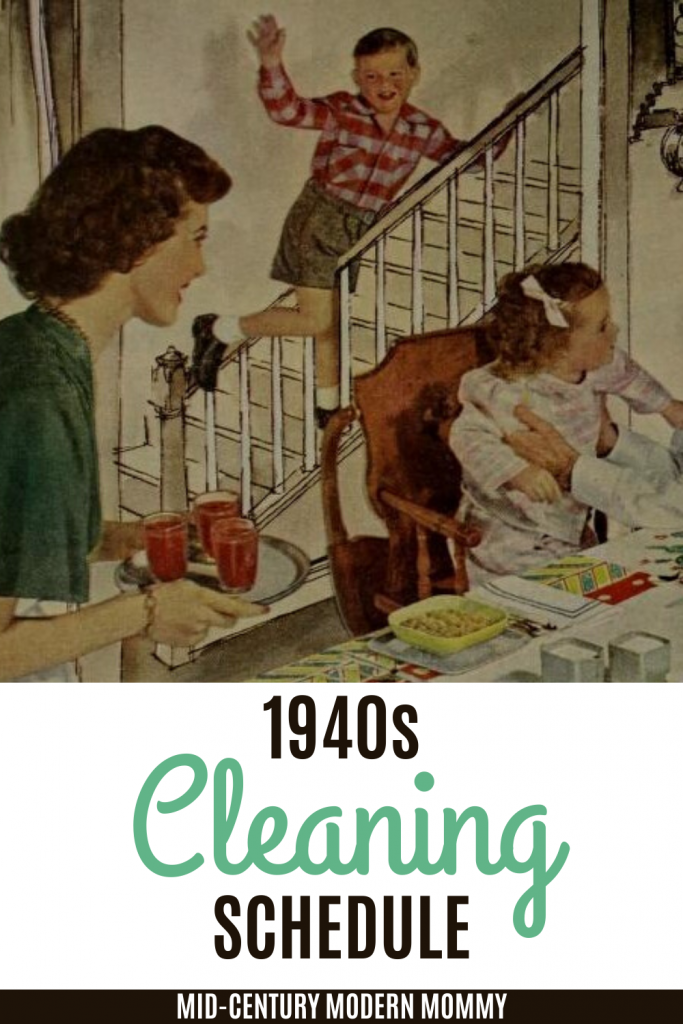
Looking for more 1940s Cleaning Schedules?


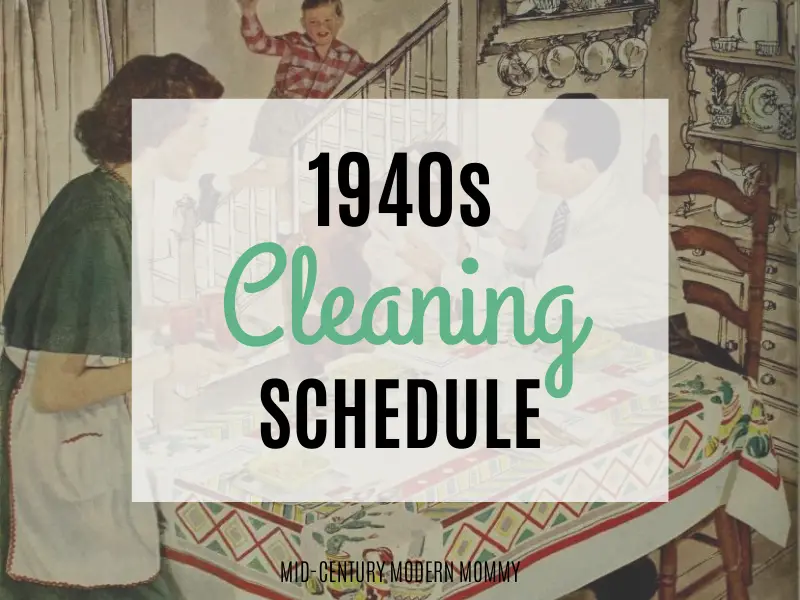
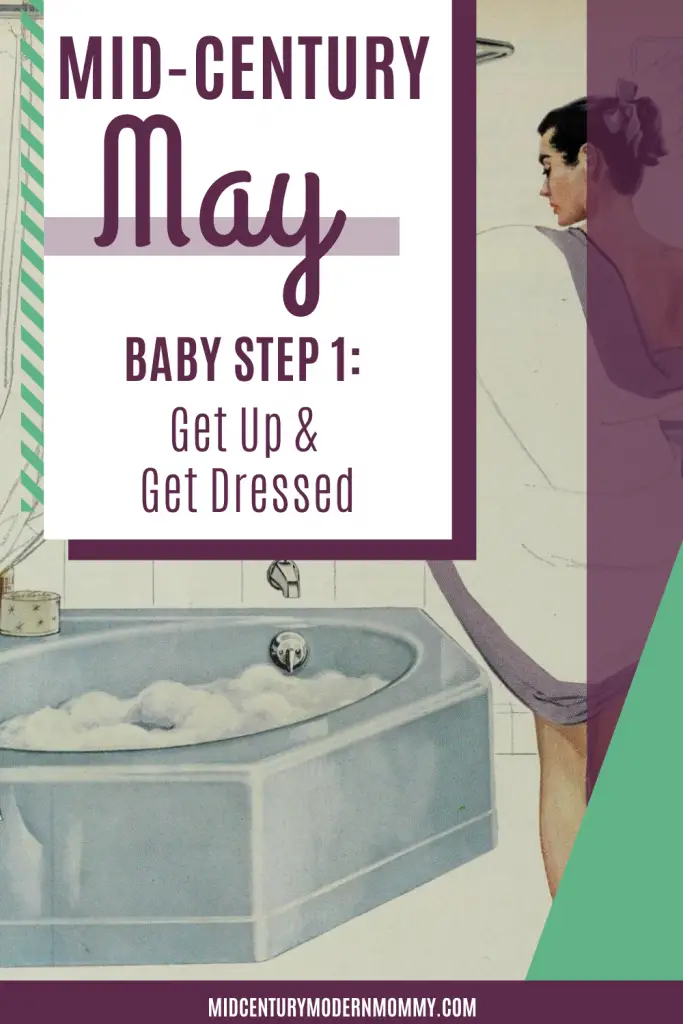
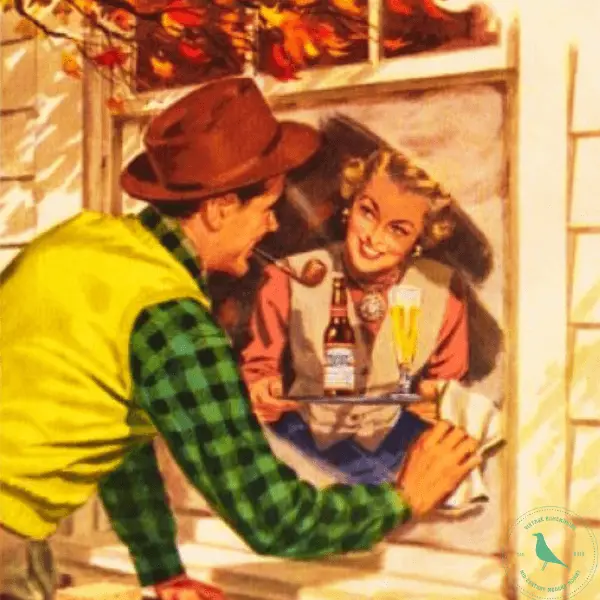
Pingback: 1940s Cleaning Routine: How to Clean a Living Room ⋆ Mid-Century Modern Mommy
Pingback: Introducing The Mid-Century May Challenge! ⋆ Mid-Century Modern Mommy
Pingback: How To Clean Your House Fast (1950s Housewife Speed Cleaning Routine) ⋆ Mid-Century Modern Mommy